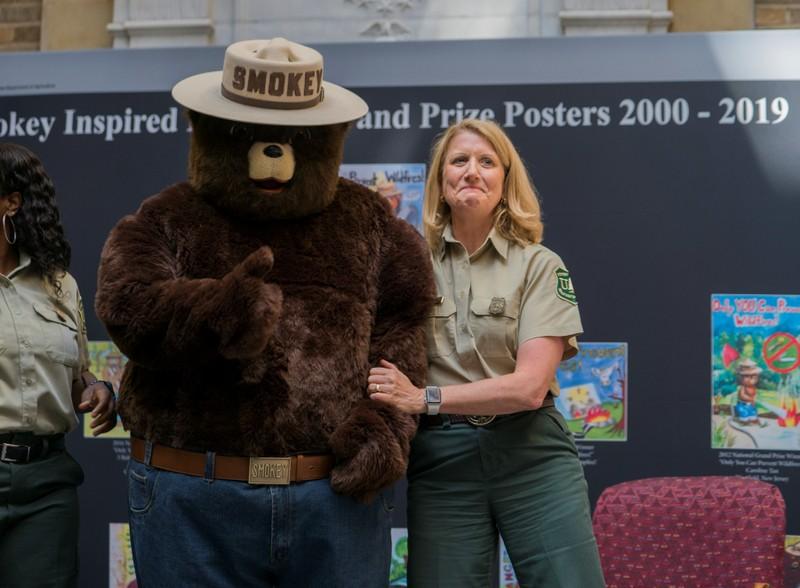The Halloween Costume You Can’t Buy
Later this month, children across the United States and beyond will dress up in costumes and go door to door, asking their neighbors for some treats. And in most cases, their neighbors will happily oblige. It’s a holiday called Halloween and it doesn’t really need much explanation.
Some children will have homemade costumes, others store-bought. Pop-up stores like Spirit Halloween or Halloween City start dotting suburban and urban landscapes starting in late August, making it rather easy for a parent who can’t sew (or who lacks the time and patience) to fork over $25 or so on a Batman, hot dog, Barbie, or inflatable alien abduction costume. But there’s one costume you won’t find for sale in any of those places: one that looks like this guy.

To be clear, I’m talking about the bear in blue jeans and the hat. For the uninitiated, that’s Smokey Bear, the embodiment of America’s efforts to stop forest fires and wildfires. In 1944, forest fires became an increasing threat in the United States, for two reasons: first, many firefighters and would-be firefighters were called into military service, which meant that any forest fire could spread widely; and second, Japan had launched a handful of incendiary balloon attacks against the U.S. mainland in an effort to start fires. In the late summer and early fall of 1944, the U.S. Forest Service introduced an ad campaign asking civilians to be sure that they put out their fires while camping; that original ad, seen here, featured a bear in blue jeans and a hat, dousing his fire, with the tagline “Care will prevent 9 out of 10 forest fires!”
The bear proved popular and quickly earned the name Smokey Bear. When the war ended, the Forest Service still kept on advertising but updated its tagline to the widely recognized “Only YOU can prevent forest fires!” as seen in this collection. For decades thereafter and continuing today, a mascot version of Smokey Bear, like the one seen above, has made public appearances around the United States, sharing his message of fire prevention.
But don’t expect Smokey Bear to show up on your doorstep on Halloween. By law, he’s not allowed to — or, rather, you’re not allowed to dress up as him. In the 1950s, Congress passed the Smokey Bear Act (pdf), keeping the iconic fire prevention character out of the public domain, and giving full authority to manage Smokey’s likeness to the Forest Service. The Forest Service strictly controls the official Smokey Bear costumes — you can sometimes rent one via the Service’s website, but it comes with many restrictions. Per that website, “the Smokey Bear costume is to be used at events where a wildfire prevention message is appropriate and actively conveyed. Examples of appropriate events include parades, appearances at schools, fairs, youth-group meetings, conservation activities, television appearances, sporting events, civic and community events, trade and trademark shows, and similar functions.” Some specific instances are explicitly disallowed — including using it for Halloween. The Forest Service continues: “Examples of inappropriate uses include Christmas and Halloween parties.” (And that’s just the tip of the Smokey Bear rules iceberg. The Forest Service has a four-page pdf available, here, outlining the “do’s and don’t’s” for use of the Smokey Bear costume. It states, in part, that “Smokey Bear should not act aggressively and should always let the public approach him first,” which makes it hard for him to trick-or-treat.)
That’s the official mascot, though — what about regular Halloween costumes? There aren’t any, as a quick search of Amazon will show. The Forest Service hasn’t yet authorized one, and making one without their permission can get you into hot water (pardon the near-pun). Per the Smokey Bear Act, anyone who “knowingly and for profit manufactures, reproduces, or uses the character [ . . . without permission . . . ] shall be fined not more than $250 or imprisoned not more than six months or both.”
Bonus fact: Smokey Bear was so popular that he lent his name to a real bear. In 1950, a three-month-old black bear cub was rescued from a fire in New Mexico and became a celebrity of sorts. Fans ultimately started calling him Smokey Bear — and he became even more popular. As the Smithsonian Institute explains, “The bear was transferred to the Smithsonian’s National Zoo as an ambassador of forest fire prevention. As a symbolic figure, Smokey was second in popularity only to Santa Claus. In April 1964, the Zoo’s Smokey Bear earned his own ZIP code, 20252, because of all the mail he was receiving.” The bear passed away in 1976, but the ZIP code is still reserved for Smokey.
From the Archives: Bearing Arms: Another story about bears in service. (And it looks like I repeated the bonus fact, oops.)
That’s the official mascot, though — what about regular Halloween costumes? There aren’t any, as a quick search of Amazon will show. The Forest Service hasn’t yet authorized one, and making one without their permission can get you into hot water (pardon the near-pun). Per the Smokey Bear Act, anyone who “knowingly and for profit manufactures, reproduces, or uses the character [ . . . without permission . . . ] shall be fined not more than $250 or imprisoned not more than six months or both.”
But while Smokey Bear costumes aren’t available for Halloweening, the bear himself encourages you to make a DIY costume and dress up your kids as everyone’s favorite forest fire-preventing bear. In September 2017, the official Smokey Bear Twitter account shared a picture of a young boy dressed just like him, with a note approving of the child’s homemade Smokey Bear costume.
